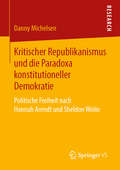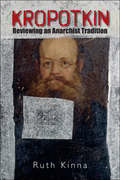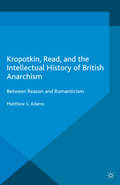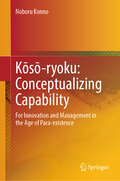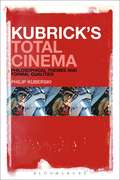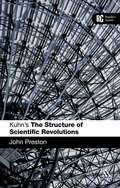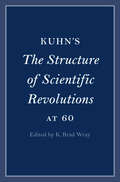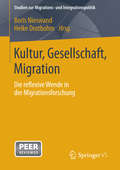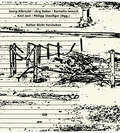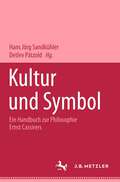- Table View
- List View
Kritischer Republikanismus und die Paradoxa konstitutioneller Demokratie: Politische Freiheit nach Hannah Arendt und Sheldon Wolin
by Danny MichelsenAuf der Grundlage eines Vergleichs von Hannah Arendts und Sheldon Wolins politischem Denken skizziert Danny Michelsen die theoretischen Grundzüge eines kritischen Republikanismus, der von einem Ideal aktiver Freiheit ausgeht und die Autonomie des Politischen betont. Ein besonderer Schwerpunkt der Untersuchung liegt auf dem Verhältnis von Politik und Recht, von Demokratie und Konstitutionalismus, dessen Bewertung im republikanischen Diskurs – gerade angesichts der in der Literatur vielfach beschriebenen „Juridifizierung“ der Politik – häufig ambivalent ausfällt. Die Frage, die insbesondere den zweiten Teil der Untersuchung leitet, lautet daher, inwieweit das republikanische Denken Arendts und Wolins Perspektiven für eine demokratische Gestaltung von Verrechtlichungsprozessen eröffnen kann.
Kropotkin: Reviewing the Classical Anarchist Tradition (Edinburgh University Press)
by Ruth KinnaThis sympathetic critical analysis corrects some popular myths about Kropotkin's thought, highlights the important and unique contribution he made to the history of socialist ideas and sheds new light on the nature of anarchist ideology.
Kropotkin, Read, and the Intellectual History of British Anarchism: Between Reason and Romanticism
by M. AdamsAlthough marginal as a political force, anarchist ideas developed in Britain into a political tradition. This book explores this lost history, offering a new appraisal of the work of Kropotkin and Read, and examining the ways in which they endeavoured to articulate a politics fit for the particular challenges of Britain's modern history.
A Kryptic Model of the Incarnation (Routledge New Critical Thinking in Religion, Theology and Biblical Studies)
by Andrew Ter LokeThe Incarnation, traditionally understood as the metaphysical union between true divinity and true humanity in the one person of Jesus Christ, is one of the central doctrines for Christians over the centuries. Nevertheless, many scholars have objected that the Scriptural account of the Incarnation is incoherent. Being divine seems to entail being omniscient, omnipotent and omnipresent, but the New Testament portrays Jesus as having human properties such as being apparently limited in knowledge, power, and presence. It seems logically impossible that any single individual could possess such mutually exclusive sets of properties, and this leads to scepticism concerning the occurrence of the Incarnation in history. A Kryptic Model of the Incarnation aims to provide a critical reflection of various attempts to answer these challenges and to offer a compelling response integrating aspects from analytic philosophy of religion, systematic theology, and historical-critical studies. Loke develops a new Kryptic model of the Incarnation, drawing from the Greek word Krypsis meaning ’hiding’, and proposing that in a certain sense Christ’s supernatural properties were concealed during the Incarnation.
A Kryptic Model of the Incarnation (Routledge New Critical Thinking in Religion, Theology and Biblical Studies)
by Andrew Ter LokeThe Incarnation, traditionally understood as the metaphysical union between true divinity and true humanity in the one person of Jesus Christ, is one of the central doctrines for Christians over the centuries. Nevertheless, many scholars have objected that the Scriptural account of the Incarnation is incoherent. Being divine seems to entail being omniscient, omnipotent and omnipresent, but the New Testament portrays Jesus as having human properties such as being apparently limited in knowledge, power, and presence. It seems logically impossible that any single individual could possess such mutually exclusive sets of properties, and this leads to scepticism concerning the occurrence of the Incarnation in history. A Kryptic Model of the Incarnation aims to provide a critical reflection of various attempts to answer these challenges and to offer a compelling response integrating aspects from analytic philosophy of religion, systematic theology, and historical-critical studies. Loke develops a new Kryptic model of the Incarnation, drawing from the Greek word Krypsis meaning ’hiding’, and proposing that in a certain sense Christ’s supernatural properties were concealed during the Incarnation.
Kōsō-ryoku: For Innovation and Management in the Age of Para-existence
by Noboru KonnoThis book examines conceptualizing capability (kōsō-ryoku), the most important ability for thriving in the era of innovation. A new approach, "formative conceptualizing capability," is proposed as the core knowledge methodology for innovation and management, which is is a fundamental human ability that goes beyond the boundaries between cognitive and tangible realities to shape concepts and drive innovation. Traditional studies on imagination in Western philosophy are combined with knowledge creation theory based on Eastern way of thinking. The book argues the capability should be at the core of innovation management, offering insights and principles for navigating the challenges of the present age. Japan has experienced the world's earliest capitalist setback and is stuck in a prolonged stagnation. The author maintains, however, that what is needed in this coming chaotic era is not only “imagination”, as it would be called in English, but also the power of creating kōsō, the Japanese term for “formative concept”. The author has a proven track record in research and practice on knowledge creation theory, innovation management, design thinking, and scenario planning. He has reorganized and set forth in this book the perspectives he has proposed under the theme of kōsō-ryoku to present a new methodology of knowledge for living in the twenty-first century.
The Ku Klux Klan: A Guide to an American Subculture (Guides to Subcultures and Countercultures)
by Martin GitlinThis history of the Ku Klux Klan traces the evolution of the organization from its 1865 founding to the present, drawing extensively on contemporaneous media reports.The Ku Klux Klan tells the story of America's oldest and largest homegrown terrorist organization. It is a revealing look at the philosophies and methods of a secret society that used religious symbols, secret codes, and the cloak of anonymity to bind its members together in the cause of violent racial warfare.The Ku Klux Klan encompasses the organization's entire history, from its post-Civil War founding by Nathan Bedford Forrest, to its high watermark in the early 20th century, with membership swelling to four million and its founders portrayed as heroes in the film, Birth of a Nation to its resurgence in the Civil Rights era, to more recent attempts by David Duke and others to put a benign face on the Klan in order to gain elective office.
Kubrick's Total Cinema: Philosophical Themes and Formal Qualities
by Philip KuberskiWhatever people think about Kubrick's work, most would agree that there is something distinctive, even unique, about the films he made: a coolness, an intellectual clarity, a critical edginess, and finally an intractable ambiguity. In an attempt to isolate the Kubrick difference, this book treats Kubrick's films to a conceptual and formal analysis rather than a biographical and chronological survey. As Kubrick's cinema moves between the possibilities of human transcendence dramatized in 2001: A Space Odyssey and the dismal limitations of human nature exhibited in A Clockwork Orange, the filmmaker's style "de-realizes" cinematic realism while, paradoxically, achieving an unprecedented frankness of vision and documentary and technical richness. The result is a kind of vertigo: the audience is made aware of both the de-realized and the realized nature of cinema. As opposed to the usual studies providing a summary and commentary of individual films, this will be the first to provide an analysis of the "elements" of Kubrick's total cinema.
Kubrick's Total Cinema: Philosophical Themes and Formal Qualities
by Philip KuberskiWhatever people think about Kubrick's work, most would agree that there is something distinctive, even unique, about the films he made: a coolness, an intellectual clarity, a critical edginess, and finally an intractable ambiguity. In an attempt to isolate the Kubrick difference, this book treats Kubrick's films to a conceptual and formal analysis rather than a biographical and chronological survey. As Kubrick's cinema moves between the possibilities of human transcendence dramatized in 2001: A Space Odyssey and the dismal limitations of human nature exhibited in A Clockwork Orange, the filmmaker's style "de-realizes" cinematic realism while, paradoxically, achieving an unprecedented frankness of vision and documentary and technical richness. The result is a kind of vertigo: the audience is made aware of both the de-realized and the realized nature of cinema. As opposed to the usual studies providing a summary and commentary of individual films, this will be the first to provide an analysis of the "elements" of Kubrick's total cinema.
Kuhn's 'The Structure of Scientific Revolutions': A Reader's Guide (Reader's Guides)
by John PrestonThomas Kuhn's The Structure of Scientific Revolutions is arguably one of the most influential books of the twentieth century and a key text in the philosophy and history of science. Kuhn transformed the philosophy and history of science in the twentieth century in an irrevocable way and still provides an important alternative to formalist approaches in the philosophy of science. In Kuhn's 'The Structure of Scientific Revolutions': A Reader's Guide, John Preston offers a clear and thorough account of this key philosophical work. The book offers a detailed review of the key themes and a lucid commentary that will enable readers to rapidly navigate the text. The guide explores the complex and important ideas inherent in the text and provides a cogent survey of the reception and influence of Kuhn's work.
Kuhn’s Structure of Scientific Revolutions - 50 Years On (Boston Studies in the Philosophy and History of Science #311)
by William J. Devlin Alisa BokulichIn 1962, the publication of Thomas Kuhn’s Structure ‘revolutionized’ the way one conducts philosophical and historical studies of science. Through the introduction of both memorable and controversial notions, such as paradigms, scientific revolutions, and incommensurability, Kuhn argued against the traditionally accepted notion of scientific change as a progression towards the truth about nature, and instead substituted the idea that science is a puzzle solving activity, operating under paradigms, which become discarded after it fails to respond accordingly to anomalous challenges and a rival paradigm. Kuhn’s Structure has sold over 1.4 million copies and the Times Literary Supplement named it one of the “Hundred Most Influential Books since the Second World War.” Now, fifty years after this groundbreaking work was published, this volume offers a timely reappraisal of the legacy of Kuhn’s book and an investigation into what Structure offers philosophical, historical, and sociological studies of science in the future.
Kuhn's The Structure of Scientific Revolutions at 60 (Cambridge Philosophical Anniversaries)
by K. Brad WrayThomas Kuhn's The Structure of Scientific Revolutions has sold more than one million copies since its publication in 1962, is one of the most cited academic books of all time, and continues to be read and studied today. This volume of new essays evaluates the significance of Kuhn's classic book in its changing historical context, including its initial reception and its lasting effects. The essays explore the range of ideas which Kuhn made popular with his influential philosophy of science, including paradigms, normal science, paradigm changes, scientific revolutions, and incommensurability; and they also look at less-studied themes in his work, including scientific measurement, science education, and science textbooks. Drawing on the latest scholarship as well as unpublished material in the Thomas Kuhn Archives at MIT, this volume offers a comprehensive way into Kuhn's philosophy and demonstrates the continuing relevance of his ideas for our understanding of science.
Kuhn's 'Structure of Scientific Revolutions' at Fifty: Reflections on a Science Classic
by Robert J. Richards Lorraine DastonThomas S. Kuhn’s The Structure of Scientific Revolutions was a watershed event when it was published in 1962, upending the previous understanding of science as a slow, logical accumulation of facts and introducing, with the concept of the “paradigm shift,” social and psychological considerations into the heart of the scientific process. More than fifty years after its publication, Kuhn’s work continues to influence thinkers in a wide range of fields, including scientists, historians, and sociologists. It is clear that The Structure of Scientific Revolutions itself marks no less of a paradigm shift than those it describes. In Kuhn’s “Structure of Scientific Revolutions” at Fifty, leading social scientists and philosophers explore the origins of Kuhn’s masterwork and its legacy fifty years on. These essays exhume important historical context for Kuhn’s work, critically analyzing its foundations in twentieth-century science, politics, and Kuhn’s own intellectual biography: his experiences as a physics graduate student, his close relationship with psychologists before and after the publication of Structure, and the Cold War framework of terms such as “world view” and “paradigm.”
Kuhn's 'Structure of Scientific Revolutions' at Fifty: Reflections on a Science Classic
by Robert J. Richards Lorraine DastonThomas S. Kuhn’s The Structure of Scientific Revolutions was a watershed event when it was published in 1962, upending the previous understanding of science as a slow, logical accumulation of facts and introducing, with the concept of the “paradigm shift,” social and psychological considerations into the heart of the scientific process. More than fifty years after its publication, Kuhn’s work continues to influence thinkers in a wide range of fields, including scientists, historians, and sociologists. It is clear that The Structure of Scientific Revolutions itself marks no less of a paradigm shift than those it describes. In Kuhn’s “Structure of Scientific Revolutions” at Fifty, leading social scientists and philosophers explore the origins of Kuhn’s masterwork and its legacy fifty years on. These essays exhume important historical context for Kuhn’s work, critically analyzing its foundations in twentieth-century science, politics, and Kuhn’s own intellectual biography: his experiences as a physics graduate student, his close relationship with psychologists before and after the publication of Structure, and the Cold War framework of terms such as “world view” and “paradigm.”
Kuhn's 'Structure of Scientific Revolutions' at Fifty: Reflections on a Science Classic
by Robert J. Richards Lorraine DastonThomas S. Kuhn’s The Structure of Scientific Revolutions was a watershed event when it was published in 1962, upending the previous understanding of science as a slow, logical accumulation of facts and introducing, with the concept of the “paradigm shift,” social and psychological considerations into the heart of the scientific process. More than fifty years after its publication, Kuhn’s work continues to influence thinkers in a wide range of fields, including scientists, historians, and sociologists. It is clear that The Structure of Scientific Revolutions itself marks no less of a paradigm shift than those it describes. In Kuhn’s “Structure of Scientific Revolutions” at Fifty, leading social scientists and philosophers explore the origins of Kuhn’s masterwork and its legacy fifty years on. These essays exhume important historical context for Kuhn’s work, critically analyzing its foundations in twentieth-century science, politics, and Kuhn’s own intellectual biography: his experiences as a physics graduate student, his close relationship with psychologists before and after the publication of Structure, and the Cold War framework of terms such as “world view” and “paradigm.”
Kuhn's 'Structure of Scientific Revolutions' at Fifty: Reflections on a Science Classic
by Robert J. Richards and Lorraine Daston Lorraine DastonThomas S. Kuhn’s The Structure of Scientific Revolutions was a watershed event when it was published in 1962, upending the previous understanding of science as a slow, logical accumulation of facts and introducing, with the concept of the “paradigm shift,” social and psychological considerations into the heart of the scientific process. More than fifty years after its publication, Kuhn’s work continues to influence thinkers in a wide range of fields, including scientists, historians, and sociologists. It is clear that The Structure of Scientific Revolutions itself marks no less of a paradigm shift than those it describes. In Kuhn’s “Structure of Scientific Revolutions” at Fifty, leading social scientists and philosophers explore the origins of Kuhn’s masterwork and its legacy fifty years on. These essays exhume important historical context for Kuhn’s work, critically analyzing its foundations in twentieth-century science, politics, and Kuhn’s own intellectual biography: his experiences as a physics graduate student, his close relationship with psychologists before and after the publication of Structure, and the Cold War framework of terms such as “world view” and “paradigm.”
Kuhn's 'Structure of Scientific Revolutions' at Fifty: Reflections on a Science Classic
by Robert J. Richards and Lorraine Daston Lorraine DastonThomas S. Kuhn’s The Structure of Scientific Revolutions was a watershed event when it was published in 1962, upending the previous understanding of science as a slow, logical accumulation of facts and introducing, with the concept of the “paradigm shift,” social and psychological considerations into the heart of the scientific process. More than fifty years after its publication, Kuhn’s work continues to influence thinkers in a wide range of fields, including scientists, historians, and sociologists. It is clear that The Structure of Scientific Revolutions itself marks no less of a paradigm shift than those it describes. In Kuhn’s “Structure of Scientific Revolutions” at Fifty, leading social scientists and philosophers explore the origins of Kuhn’s masterwork and its legacy fifty years on. These essays exhume important historical context for Kuhn’s work, critically analyzing its foundations in twentieth-century science, politics, and Kuhn’s own intellectual biography: his experiences as a physics graduate student, his close relationship with psychologists before and after the publication of Structure, and the Cold War framework of terms such as “world view” and “paradigm.”
Kuhn's 'Structure of Scientific Revolutions' at Fifty: Reflections on a Science Classic
by Robert J. Richards and Lorraine Daston Lorraine DastonThomas S. Kuhn’s The Structure of Scientific Revolutions was a watershed event when it was published in 1962, upending the previous understanding of science as a slow, logical accumulation of facts and introducing, with the concept of the “paradigm shift,” social and psychological considerations into the heart of the scientific process. More than fifty years after its publication, Kuhn’s work continues to influence thinkers in a wide range of fields, including scientists, historians, and sociologists. It is clear that The Structure of Scientific Revolutions itself marks no less of a paradigm shift than those it describes. In Kuhn’s “Structure of Scientific Revolutions” at Fifty, leading social scientists and philosophers explore the origins of Kuhn’s masterwork and its legacy fifty years on. These essays exhume important historical context for Kuhn’s work, critically analyzing its foundations in twentieth-century science, politics, and Kuhn’s own intellectual biography: his experiences as a physics graduate student, his close relationship with psychologists before and after the publication of Structure, and the Cold War framework of terms such as “world view” and “paradigm.”
Kultur, Gesellschaft, Migration.: Die reflexive Wende in der Migrationsforschung (Studien zur Migrations- und Integrationspolitik)
by Boris Nieswand Heike DrotbohmDer Sammelband arbeitet den Beitrag von Reflexivität für das Verständnis der Beziehung von Kultur, Gesellschaft und Migration anhand von drei Schwerpunkten heraus: 1. Politiken kultureller Differenz 2. Transnationale Perspektiven 3. Ethnizität und Diversität. Dafür werden Autorinnen und Autoren mit unterschiedlichen disziplinären Hintergründen aus Deutschland, Österreich, der Schweiz und den USA zusammengeführt. Im Zentrum steht die Beziehung zwischen der intellektuellen Krise, welche die bisherigen Grundbegriffe der Integrations- und Migrationsforschung erfasst hat, und der Entwicklung neuer thematischer Zuschnitte, theoretischer Konzepte und Forschungsansätze.
Kultur in Stücken: Barthes, Brecht, Artaud (Edition Moderne Postmoderne)
by Melanie ReichertDie Erschütterungen neuzeitlicher Gewissheitsordnungen haben das menschliche Selbst- und Weltverständnis in eine tiefe Krise gestürzt. Darauf antworten Bertolt Brecht und Antonin Artaud wie auch ihr Rezipient Roland Barthes mit einem Theater des Nichtverstehens - sowohl auf der Bühne wie auch im Text. Dieses Theater zeigt, dass Kultur in erster Linie ein ästhetisches System und daher immer ein riskanter Prozess ist. Melanie Reichert überführt die drei bisher vor allem literatur- und kunstwissenschaftlich gelesenen Autoren in einen kulturphilosophischen Diskurs über Philosophie, Theater und die Wiederentdeckung der Ambiguitätstoleranz nach dem Scheitern der Ideologiekritik.
Kultur - Interdisziplinäre Zugänge
by Hubertus Busche Thomas Heinze Frank Hillebrandt Franka SchäferEine interdisziplinäre Verständigung über Kultur ist fällig und notwendig, um dem gegenwärtig weit verbreiteten Eindruck entgegenzuwirken, „Kultur“ habe sich als semantisches Irrlicht und als obsolet gewordener Gegenstand von Forschung erwiesen, weil der Begriff unüberschaubare wie unvereinbare Bedeutungsmomente bündele und aus einem bloßen Gespinst von Mehrdeutigkeiten bestehe. Demgegenüber wird in diesem Buch die Überzeugung vertreten, dass es gewinnbringend ist, die spezifischen Kompetenzen aus der Kultursoziologie und Populärkulturforschung, aus der Theorie des Kulturmanagements und der Medienkultur sowie aus der Kulturphilosophie zusammenzubringen, um zu zeigen, dass es trotz und gleichsam unterhalb der notorischen Vieldeutigkeit des Wortes „Kultur“ einen gemeinsamen Sachzusammenhang namens Kultur gibt, von dem die einzelnen Fachdisziplinen jeweils bestimmte Faktoren in den Blick nehmen und kraft ihrer eigenen Methoden erhellen. Damit leistet der Band einen wichtigen Beitrag, um den vielschichtigen und komplexen Terminus „Kultur“ als sozial- und kulturwissenschaftlichen Schlüsselbegriff wiederzugewinnen.
Kultur Nicht Verstehen: Produktives Nichtverstehen und Verstehen als Gestaltung (Edition Voldemeer Zürich)
Für gewöhnlich versteht man die Welt, in der man lebt. Man kommt zurecht, auch wenn man im Einzelnen manches nicht versteht. Das ist in der Regel kein Problem – aber gelegentlich wird es zum Problem. Und das kann Folgen haben, bis dahin, dass man "die Welt nicht mehr versteht", oder dass sich der Verdacht regt, unterhalb unseres Verstehens gähne der Abgrund des eigentlich gar nichts Verstehens? Ist "zu verstehen" nur eine Gewohnheit, die uns lieb geworden ist? In den vorliegenden Beiträgen wird "Nicht Verstehen" aus verschiedenen Perspektiven angegangen: jenen von Literaturwissenschaft, Philosophie, Religionsphilosophie, Wissenschaftstheorie, Theologie, Kunst-, Film- und Medienwissenschaften, Kulturwissenschaft und Psychologie.
Kultur und Praxis der Wahlen: Eine Geschichte der modernen Demokratie
by Hedwig Richter Hubertus BuchsteinWas ist eigentlich der Sinn und Zweck des Wählens? Warum gelten Wahlen seit dem 20. Jahrhundert für nahezu alle Staaten als unverzichtbar? Um die Erfolgsgeschichte und die variierenden Bedeutungen von Wahlen zu verstehen, gilt es, die historische Dimension zu berücksichtigen und mit einem anthropologisch interessierten Blick neue Fragen zu stellen. Diese Neue Wahlgeschichte lässt den scheinbar so selbstverständlichen Gegenstand „Wahlen“ erklärungsbedürftig erscheinen. Sie fragt nach Praktiken, Materialität, Ideen und Diskursen, um die Funktionen politischer Wahlen in verschiedenen historischen und politischen Kontexten von Europa über Nordamerika bis hin nach Lateinamerika zu ergründen. Da das Interesse dem Massenwahlrecht als Grundlage moderner Demokratien gilt, richtet sich der Fokus auf das 19. und 20. Jahrhundert.
Kultur und Symbol: Ein Handbuch zur Philosophie Ernst Cassirers
Ernst Cassirer (1874-1945) sieht die moderne Zivilisation in einer Krise der Selbsterkenntnis. Er begegnet ihr, geschult an Kant, auf den Spuren des humanistischen Denkens und der Aufklärung und in engster Verbindung zu den Wissenschaften. Diese Philosophie in ihrer Gesamtheit vorzustellen, ist das Ziel des Handbuchs. Cassirers Hauptwerk - die "Philosophie der symbolischen Formen" - gehört zu den großen Theorieentwürfen des 20. Jahrhunderts. Ihr Ziel ist eine Philosophie über die Kultur der Freiheit, ein pluralistisches Veto gegen die Preisgabe von Rationalität und Menschenrechten.
